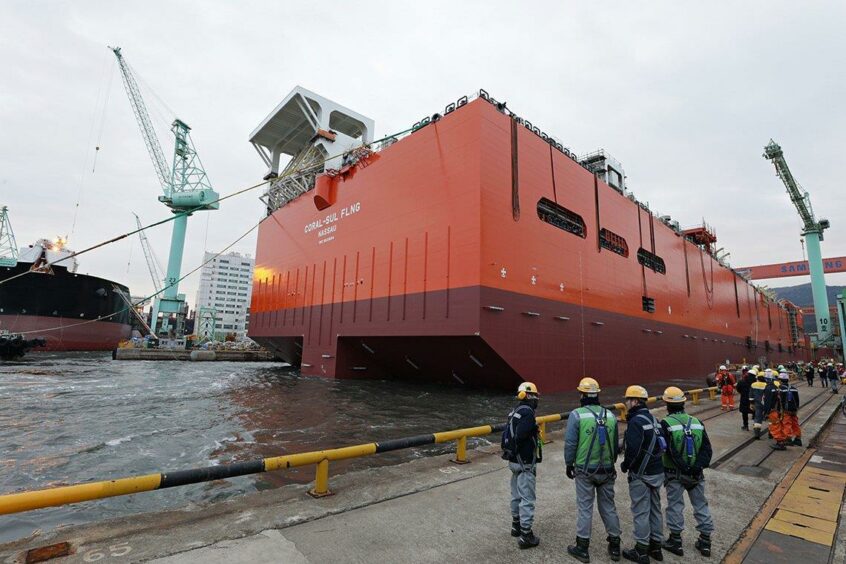
High gas prices represent an opportunity for those already producing, but those working on new supplies are feeling the need to accelerate plans. Floating LNG (FLNG) offers one solution, being faster to market than onshore projects.
Golar LNG, in its second quarter results, confirmed that it is working on new floating LNG plans. The company said it had engaged a number of new clients during the last three months on discussions around new FLNG projects.
Golar said it could provide liquefaction capacity at a cost of $500-600 per tonne. Its MKI and MKII designs can be ready by 2025, it said, if ordered by the end of the year.
It has begun working up engineering and ordering long-lead items for a new FLNG vessel this year. The project, which would be converted from an existing vessel, would have capacity of 3.5 million tonnes per year.
It aims to announce an FLNG project this year, it said.
The company has experience in FLNG projects. Its Hilli Episeyo vessel, in Cameroon, has been producing for Perenco for four years.
It is also in the process of building the $1.4 billion Gimi vessel for BP, for deployment of Senegal and Mauritania at Tortue Phase 1. The vessel is 86% complete, it said, and is on schedule for a start up in the fourth quarter of 2023.
Cash flows
The two FLNG vessels, once both producing, could provide Golar with adjusted EBITDA of more than $400mn per year, it said.
Kosmos Energy CEO and chairman Andy Inglis has predicted more to come from its gas plans. Kosmos is a junior partner in the Tortue project.
“Gas prices will remain higher for longer and dislocated from oil,” he said during a recent conference call. As a result, once producing at Tortue, Kosmos plans to divert cargoes from contracted deliveries to take advantage of high prices.
The company will pay a penalty, perhaps of around 20-30% of the Brent-linked contract price. Inglis explained that, based on future gas prices for 2024-25, paying the oil-linked penalty and gaining gas-price exposure could see the company net an additional $200-350mn.
“It’s a significant opportunity for us, we’ve started the engagement process with prospective buyers,” he said.
Next steps
Kosmos is making plans for more LNG production in the region. While Tortue phase 1 will reach first LNG by the end of 2023, the companies are considering a second phase.
“We’re taking the time to get the right project for phase 2,” Inglis said. An initial decision will come in the third quarter, paving the way for engineering studies and design work. “We expect to go to the government with results and then take final investment decision in 2023, with first gas in 2026-27.”
While gas prices are attractive, inflation is driving up costs across the sector. Inglis said the company aimed to pin down a development that “best lets us take advantage of current market conditions and the optimum scope for managing inflationary pressures”.
The first phase gives an indication of what Kosmos is aiming for in the second, the executive said. The company is building a relationship with customers, he said, with the aim of securing “contracts that give real exposure to gas prices”.
Kosmos expects to be able to move ahead with the second phase at Tortue without requiring any additional financing, Inglis said. “The incremental capital is modest, it’s less than $1 billion.”
Speed to delivery
Another company with a taste for FLNG is Eni. The Italian company is in the process of starting up its Coral Sul project, offshore Mozambique, and sees similar technology playing a role in West Africa.
In early August, Eni said it had bought Exmar Group’s Tango FLNG vessel. It will use this in Congo Brazzaville, to develop gas resources on the Marine XII block.
Tango can produce around 0.6mn tpy of LNG, equivalent to 1 billion cubic metres of gas. Buying this existing vessel will allow Eni to accelerate production start up, it said, aiming to begin in the second half of 2023.
Exmar reported Eni would pay $572-694mn, the range being determined by its initial performance. Eni is also chartering an FSU from Exmar for 10 years.
In addition to the shallow-water Tango vessel, Eni has also struck a preliminary deal with New Fortress Energy (NFE) for a Fast LNG project in Congo. NFE has struck a number of deals on its Fast LNG technology, most recently with a focus in the Americas.
Eni executives have expressed interest in more FLNG vessels in Mozambique, to complement the existing Coral Sul. CEO Claudio Descalzi, speaking in July, said the plan would see the “same Fast LNG that we are developing in Congo” in the East African state. “The offshore option would be the faster one.”
Safer offshores
Such a move offers an appealing combination of speed to delivery, in addition to avoiding some of the onshore security challenges that have bogged down TotalEnergies’ Mozambique LNG.
Onshore LNG plans have tended to move slowly, even when not subject to force majeure as seen in Mozambique.
The proliferation of LNG plans in the offshore offers an option to skip some of the challenges – but there are also difficulties involved in such a shift.
As Kosmos has highlighted, costs are rising through the sector, particularly at a time when yard capacity is increasingly constrained.
Furthermore, the road to production does not always run smoothly, as Shell has demonstrated at its Prelude FLNG project, offshore Australia. When things go wrong, it is that much more challenging in such an environment.
However, the speed to deliver gas puts FLNG at a clear advantage. With a number of such projects due to get under way in Africa in the near future, time is of the essence.

